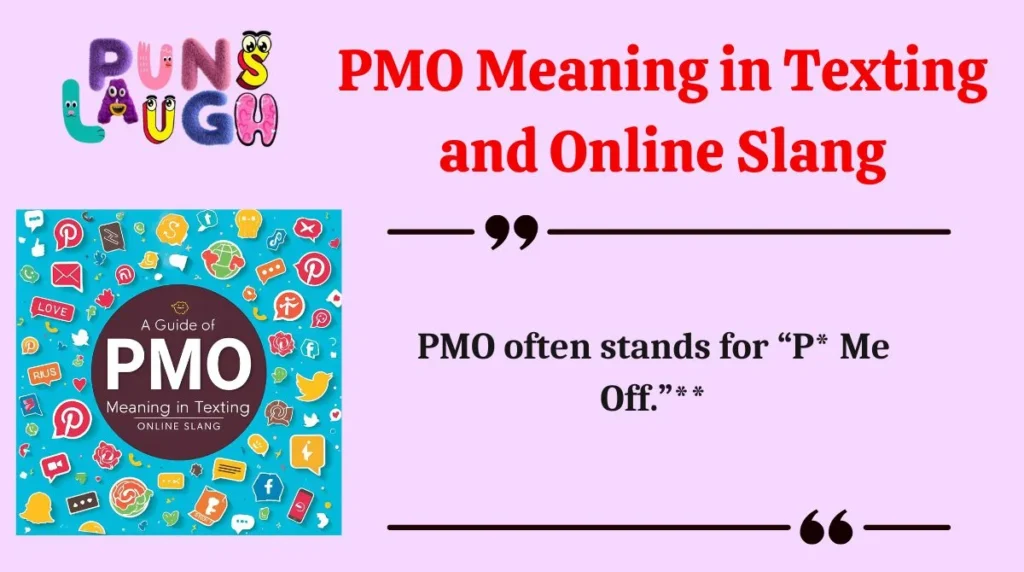Last updated on October 17th, 2025 at 05:36 am
Understanding PMO meaning can be confusing. In one chat, it might mean something sarcastic.
In another, it could represent the backbone of a company’s project management strategy.
This guide breaks down every important use of PMO—from social media slang to the role of the Project Management Office in modern organizations.
Why PMO Matters in Different Contexts
Acronyms thrive on the internet, and PMO is one of the most versatile. In texting, it usually conveys a strong emotion. In the corporate world, it points to a formal structure that guides projects to success.
Knowing the right meaning of PMO depends on context. Misinterpreting it could lead to awkward misunderstandings online—or even mistakes in a business setting.
This post unpacks PMO meaning in slang and pop culture and dives deep into its critical role in business and project management. By the end, you’ll know how to use it correctly in any situation.
PMO Meaning in Texting and Online Slang

On the internet, especially in informal conversations, PMO often stands for “P* Me Off.”** It’s a quick way to express frustration or annoyance.
People use it when something irritates them, from a bad game update to a friend’s late reply.
“That app crashing again really PMO!”
In slang culture, acronyms save time and fit the fast pace of texting, memes, and comments.
PMO in Text Messages
Texting culture thrives on brevity. PMO pops up frequently when people don’t want to type long sentences to vent their feelings.
For example:
- “The traffic jam this morning really PMO.”
- “Stop canceling plans last minute. It PMO every time.”
It’s informal and best avoided in professional or respectful conversations.
PMO on TikTok
TikTok’s algorithm rewards trends. PMO often appears as a hashtag or caption in short videos that showcase funny, irritating, or outrageous moments.
Examples:
- A clip of a coffee spill titled: “This kind of morning really #PMO”
- Trendy reaction videos showing exaggerated annoyance with the hashtag #PMO
The acronym resonates with TikTok’s younger audience because it’s relatable and catchy.
PMO on Snapchat and Instagram
Snapchat and Instagram users often include PMO in captions, stories, or reactions.
Typical use cases include:
- Responding to a frustrating moment in daily life.
- Reacting to annoying online trends.
- Highlighting a “fail” moment, like spilling food or losing an online game.
The rise of ephemeral stories on these platforms has made short, impactful acronyms like PMO even more popular.
PMO in Urban Dictionary
Crowdsourced platforms like Urban Dictionary reflect how slang evolves.
Here, PMO is consistently defined as “P*** Me Off,” but often accompanied by humorous, exaggerated examples. It’s a testament to how widely the acronym is understood in casual online communities.
Variations of PMO in Slang
Language online changes quickly. Variations of PMO include:
- PMO’d – Past tense, e.g., “That delay really PMO’d me.”
- PMOS – A less common pluralized form.
- Regional tweaks – Some subcultures use PMO with emojis or abbreviations for emphasis.
These variations show the acronym’s flexibility but keep its meaning rooted in expressing irritation.
PMO Meaning in Business and Project Management
In the professional world, PMO stands for Project Management Office—a completely different meaning.
A PMO is a department or team that defines standards, provides guidance, and supports project execution across an organization.
Its role is critical for maintaining consistency, efficiency, and quality in project delivery.
“A strong PMO transforms chaos into a roadmap for project success.”
Core Objectives of a PMO
A PMO’s primary objectives include:
- Standardization: Defining processes, templates, and reporting formats.
- Governance: Ensuring compliance with organizational policies.
- Alignment: Keeping projects in sync with business goals.
- Optimization: Improving project delivery performance.
These objectives directly improve project predictability and business outcomes.
Types of PMOs
Organizations adopt different types of PMOs based on their needs:
- Supportive PMO: Offers tools, best practices, and training.
- Controlling PMO: Enforces compliance with processes and standards.
- Directive PMO: Directly manages projects and resources.
A start-up might prefer a supportive PMO for flexibility, while large corporations often rely on directive PMOs for tight control.
Core Functions of a PMO
A PMO typically performs these key functions:
- Resource Allocation: Assigning people and tools to projects efficiently.
- Risk Management: Identifying and mitigating risks before they escalate.
- Performance Monitoring: Tracking KPIs and deadlines.
- Reporting: Providing leadership with clear project insights.
- Training and Development: Enhancing project managers’ skills.
These functions serve as the backbone of effective project delivery.
PMO Categories by Organizational Hierarchy
The placement of a PMO in an organization affects its scope:
| Category | Focus Area | Typical Use Case |
|---|---|---|
| Enterprise PMO | Entire organization | Strategic alignment across all projects |
| Departmental PMO | Specific department or function | Specialized projects like IT or HR |
| Project-Specific PMO | Single project or program | Large-scale, high-impact initiatives |
Understanding these categories helps organizations pick the right model for their size and goals.
PMO in Real Organizations
Many successful companies have reaped benefits from establishing PMOs.
Case Study – IBM:
IBM’s global PMO introduced standardized project practices, reducing project delays by 20% and improving cost predictability.
Case Study – NASA:
NASA’s PMO ensures mission-critical projects meet strict timelines and budgetary requirements, proving the necessity of strong governance in high-stakes environments.
These examples highlight how a well-structured PMO can drive tangible results.
PMO Software and Tools
Modern PMOs rely on specialized software to streamline workflows:
- Jira – Best for agile project tracking.
- Asana – User-friendly for team collaboration.
- Wrike – Offers robust reporting features.
- Monday.com – Highly visual for planning and task management.
- Microsoft Project – Traditional choice for large-scale enterprise projects.
The right tools reduce manual errors and enhance visibility across projects.
PMO Certifications and Membership
Professional development boosts PMO effectiveness. Recognized certifications include:
- PMO-CP (Certified Practitioner)
- PMP (Project Management Professional)
- PRINCE2 (Projects in Controlled Environments)
Membership in organizations like the PMI (Project Management Institute) connects professionals to industry updates and best practices.
Common PMO Challenges
Despite their benefits, PMOs face obstacles such as:
- Resistance to Change: Teams may resist standardized processes.
- Unclear Roles: Confusion about PMO authority versus project managers.
- Stakeholder Misalignment: Conflicting priorities hinder progress.
- Inconsistent Metrics: Poorly defined KPIs obscure performance insights.
Overcoming these challenges requires strong leadership, communication, and adaptable frameworks.
PMO ROI and Benefits
A well-implemented PMO delivers substantial returns:
- Improved Delivery: Projects finish on time and within budget.
- Strategic Focus: Prioritizes initiatives aligned with business goals.
- Resource Efficiency: Reduces waste and duplication of effort.
- Risk Reduction: Mitigates costly project failures.
Studies show that organizations with mature PMOs achieve 30–40% higher project success rates compared to those without.
PMO vs Project Manager
It’s important to differentiate between the two roles:
| Feature | PMO | Project Manager |
|---|---|---|
| Scope | Organization-wide processes | Individual projects |
| Focus | Governance, strategy, oversight | Execution and delivery |
| Accountability | Senior leadership, enterprise goals | Project sponsors, stakeholders |
| Skill Set | Policy-making, metrics, training | Tactical planning, team leadership |
A PMO supports and guides, while project managers execute specific projects.
The Future of PMO
As businesses adapt to remote work and data-driven strategies, PMOs are evolving:
- AI-Powered Insights: Forecasting project risks and outcomes.
- Remote Collaboration Tools: Managing distributed teams effectively.
- Data-Driven Decision Making: Using analytics to guide project priorities.
- Hybrid Project Approaches: Combining agile and traditional methodologies.
PMOs are shifting from being process enforcers to strategic partners in innovation.
Quick Comparison Table – All PMO Meanings
| Context | Meaning | Typical Use Case |
|---|---|---|
| Slang/Texting | PMO = “P*** Me Off” | Expressing frustration in casual chats |
| Business/Professional | PMO = Project Management Office | Project governance and efficiency |
| Other Niche Uses | Occasionally in specific industries | Specialized internal jargon |
FAQs about PMO Meaning
What does PMO stand for in slang?
In texting and online slang, PMO means “P*** Me Off,” used to express irritation or annoyance.
What does PMO stand for in business?
In a corporate setting, PMO refers to the Project Management Office, which provides guidance, oversight, and resources for projects.
Why is a PMO important for organizations?
A PMO ensures consistent processes, strategic alignment, and higher project success rates by standardizing practices across teams.
Can a small business benefit from a PMO?
Yes. Even a small business can use a supportive PMO model to improve project efficiency without heavy bureaucracy.
What skills are essential for PMO professionals?
Key skills include leadership, strategic thinking, process optimization, data analysis, and stakeholder communication.
Conclusion
PMO meaning changes dramatically based on context. In social media slang, it’s a quick way to vent frustration.
In business, it represents a vital function that drives project efficiency and organizational success.
Recognizing the difference prevents misunderstandings and empowers you to use the term correctly, whether you’re texting a friend or leading a major project.





